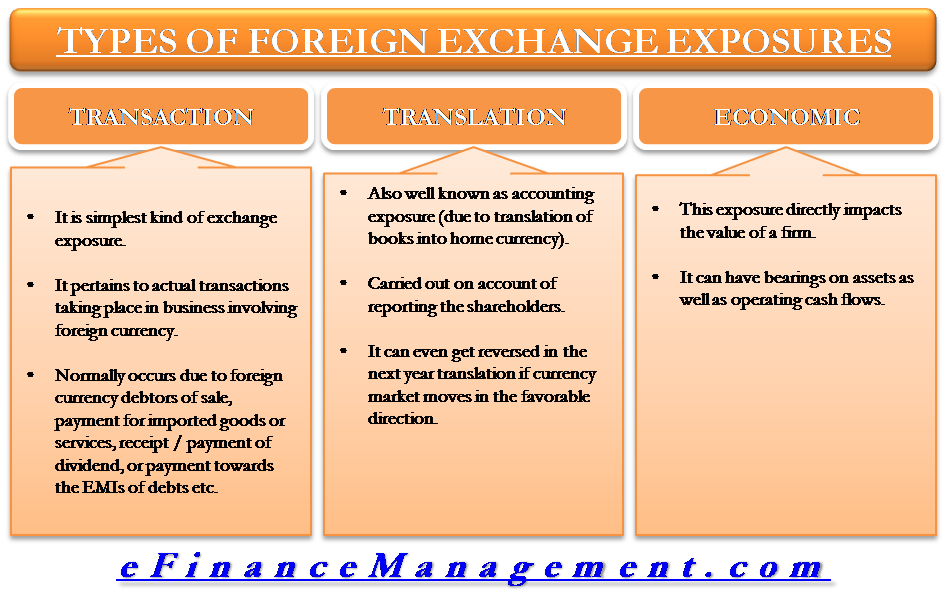Foreign exchange exposure is classified into three types, viz. translation, transaction, and economic exposure. Transaction exposure deals with actual foreign currency transactions. Translation exposure deals with the accounting representation, and economic exposure deals with little macro-level exposure, which may be true for the whole industry rather than just the firm under concern. Let us see in detail the Types of Foreign Exchange Exposure.
Foreign exchange exposure exists for a business or a firm when the value of its future cash flows is dependent on the value of foreign currency/currencies. If a British firm sells products to a US Firm, the cash inflow of the British firm is exposed to foreign exchange. And in the case of the US-based firm, cash outflow exposes to foreign exchange. Why are we so skeptical about this exposure? Simple! It is because the exchange rates tend to change or fluctuate.
In the above situation, we saw how a firm directly involved in foreign currency dealing is exposed to foreign exchange risk. It may be surprising to know that a firm with no such direct connection may also be found exposed to foreign currency risk. For example, if a company producing small electronics products in Sri Lanka competes against the products imported from China.

Now, if the price of the Chinese Yuan per Sri Lankan Rupee decreases, there will be a decrease in cost advantage to the importers over that Sri Lankan company. It is evident from the example that the firm that has no direct access to forex can also face the impact.
Also Read: Transaction Exposure
Commonly, the exposure is classified into three types of foreign currency exposure:
Transaction Exposure
The most superficial foreign currency exposure that anybody can easily think of is transaction exposure. As the name itself suggests, this exposure pertains to the exposure due to an actual transaction taking place in business involving foreign currency. All monetary transactions aim for profits as their end results in a business. There are all the chances of that final objective to get hamper if it is a foreign currency transaction. And the currency market moves in an unfavorable direction.
If you have bought goods from a foreign country and payables are in foreign currency payable after three months. Then, you may end up paying much higher on the due date as currency value may increase. This will increase your purchase price. And therefore, the overall cost of the product compels the profit percentage to go down or even convert to loss.
Transaction exposure occurs typically due to foreign currency debtors of sale, payment for imported goods or services, receipt/payment of dividend, payment towards the EMIs of debts, etc.

Translation Exposure
The other name for this exposure is accounting exposure. It is because the exposure is due to the translation of books of accounts into the home currency. Translation activity is carried out on account of reporting the books to the shareholders or legal bodies. It also makes sense as the translated financial statements show the company’s position as on a date in its home currency.
Also Read: Transaction vs Translation Exposure
Gains or losses arising from translation exposure do not have more meaning over and above the reporting requirements.
Such exposure can even get reversed in the next year’s translation if the currency market moves in a favorable direction. This kind of exposure does not require too much management attention.
To know the difference between the two, visit our article Transaction vs Translation Exposure.
Economic Exposure
This type of exposure’s impact and importance is much higher than the other two. Economic exposure directly impacts the value of a firm. That means the foreign exchange influences the value of the firm.
The value of a firm is the function of operating cash flows and its assets. The economic exposure can have bearings on assets and operating cash flows. Identification and measuring this exposure is a difficult task. Although the asset exposure is still measurable and visible in books, the operating exposure has links to various factors such as competitiveness, entry barriers, etc. Which are pretty subjective, and the interpretation of different experts may be different.
These three types of foreign currency exposures are very important for an international finance manager. Analyzing the exposure to foreign exchange helps have the correct view of the firm’s business and therefore make informed decisions.
Also, read – Transaction vs Economic Exposure.
Quiz on Types of Foreign Exchange (Currency) Exposure
Let’s take a quick test on the topic you have read here.


Good and informative
Thanks for the information
how can we manage all these foreign currency exposure?
Hello Nalule Anita. Well, we actually have different techniques on how to manage this kind of transaction exposure cause by fluctuation of exchange rates. Some of these are by entering into so-called hedging activities like forward contract and option contract with third party usually with a bank. This is like a betting game of how will the exchange rates will looks like in the future by locking the price today. But remember, each may have its own pros and cons. Just a birds eye view. God bless!
Clear information
I wanted to thank you for this great read!! I definitely enjoying every little bit of it I have bookmarked you to check out new stuff you post.
I loved up to you will obtain performed right here.